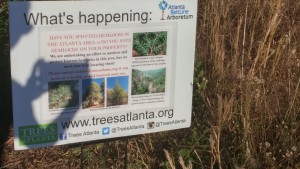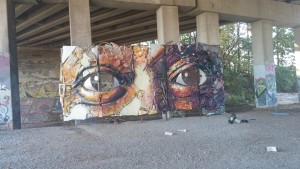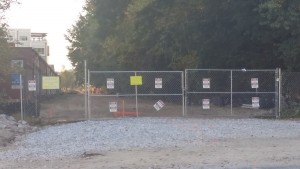Built Environment Description 4 (Final)

The Beltline began as a project entirely about the public, where plans were not made without first consulting the communities already existing where the Beltline would go. As time has passed however, the rosy promise of the Beltline has faded for some people. The Beltline cannot truly cater to everyone’s wishes, and someone must suffer at the expense of others. The Beltline is a piece of infrastructure that does more good for people than bad, however there are some areas where it could perhaps improve or at least consider the needs of the people a bit more.
The Atlanta Beltline is a major piece of construction that re-purposes the 22 mile railroad that circles Atlanta to link multiple neighborhoods, parks, markets, and businesses. The Beltline helps the community in many ways by connecting people to what they need, by providing a safe, healthy environment, and by reusing old space that would have just been turned into more buildings most likely.
Ryan Gravel, the one responsible for dreaming up the Beltline in the first place, visits the Beltline quite often. In his book he states that the main purpose of the Beltline was to connect people to what they need without the use of a car. He finds joy in a woman walking along the Beltline to pick up her groceries, as that is the exact type of connection he wanted to make. Businesses such as the Atlanta Beltline Bicycle Shop and multiple restaurants have opened up to cater to people’s needs. Housing has sprung up all over the Beltline, as well as art that shifts and changes quite often. The Beltline itself is not very advertised, mostly only the locals of Atlanta know about it. It is not designed to be a tourist destination necessarily, but rather a venue for those who live in the city to get around. Where there is people, there is culture, and because the Beltline facilitates so much traffic, the environment is a canvas to express themselves and make it into what they desire.
The Beltline creates trails for people to get outside and get active in nature, thus building a community that could potentially have better health. Not only that, the way it is designed protects people and the environment from water run off and physical damage that nature could cause. The Beltline has its very own arboretum, with various kinds of trees that help the environment and add to the physical beauty of the Beltline
In regards to transit, MARTA and the Beltline are designed to come together to create public transportation for connecting all of Atlanta. As of right now the Beltline is mostly used for recreation purposes, but the hope is eventually it will take away some of the traffic provided by people in cars when they use the services offered by the Beltline MARTA route.
The idea of the Ponce City Market is similar to the Beltline- create something new while still alluding to the history of the area. The whole idea behind the Beltline movement is to give new life to old railroad tracks and convert it into a space that caters to people and gives them an opportunity get to know the city of Atlanta more intimately. It is a very novel idea, and one that is being replicated across the United States. All over cities are seeking to revitalize their old unused areas and put them to work for the people. The Beltline has really put people in closer proximity to what they need, which is essential for the people who live in the city.
In the beginning, there were many different agencies and groups that got together to draft out the Beltline and make sure it included all the things the community found important, such as affordable housing, an arboretum, and transit. Today, many of these groups still exist and are pushing hard for policies to pass that reflect the way Atlantans want to live. One of the ways the Beltline is making its concerns known is on the ballot November 8th 2016. They were proposing a nine-tenth of a penny increase on the sales tax in order to fund various projects throughout the city. The tax would raise $2.5 billion over 40 years for MARTA, and $300 million for the city of Atlanta.
Few are still not impressed however, and think the tax is negative as it might take from low-income workers or think there are enough sales taxes. Others believe that the city should spend money for transportation on places but the Beltline. Many are upset about the Beltline plans because they feel it is taking funds out where it is not appropriate, such as money for education is going toward the Beltline. Others think the project is focusing on building transit in places where it would really not help those stuck in traffic, such as the suburbs and the city of Atlanta.
A huge concern since the beginning of the Beltline idea was the inclusion of affordable housing. Along the Eastside Trail this has not materialized, as the value of the space went up, so did the cost to live there. There is also worry that community of the neighborhoods that exist now will be displaced or substituted by gentrification of the Westside Trail, as this has already occurred with the Eastside Trail. Even though their are hopes for good prices and maintaining community in this area, it seems that many have lost faith that it will be a reality. Some of these issues were unforeseen, while others were, but there is only so much the Beltline can do for issues such as these. Unfortunate as they are, problems such as an increase in housing and gentrification are only a by-product of the Beltline’s success, and not one that the Beltline could really control.
For the past couple of years, the Atlanta Public School system and the Atlanta Beltline Institution have been battling over money and areas for building. Only in January, 2016, did they finally resolve their differences. For a while, the API was struggling with paying the amount of money that was due to the schools, as the figure was drawn up based on the economy as it was 10 years ago, not as it is now. The dilemma was if the Beltline paid the money it owed to the school, there would be no money to fund the construction of expanding the Beltline. The API withheld money from the APS for two years, and progress was halted as negotiations were trying to be made about the money.The API finally agreed to pay the money to APS that was due, and in return APS let the Beltline off the hook for much of it’s debt. Ever since, the Beltline has moved forward in it’s vision without any problems, at least concerning relations with the school system.
The dilemma with the school system reflects the entire nature of the Beltline. A project as extensive as the Beltline is bound to have some problems, but each time it has overcome. Take for another example the situation about transit along the Beltline involving an activist named Angel Poventud. Angel was involved in a dispute about the grade (basically the steepness of a hill) for light transit. He was being told that the grade was too steep, and light rail would not be possible. Not accepting that for an answer, Angel called all over the United States until he finally found a city with light rail that had a grade steeper than the one the Atlanta Beltline would have. After this event, construction has proceeded as planned. The Beltline has overcome these obstacles because there are a lot of people working hard to make this happen. They believe in the Beltline because it supports the community and offers more pros than cons.
The benefits of the Beltline are astounding, and predicted to grow as more of the Beltline is built. The Beltline project is projected to be finished in the course of 30 years, and it is only on the first decade. The Beltline is also growing quite rapidly, and is picking up the pace as more time goes by as people get more familiar with what they want from the Beltline. The Eastside Trail took 6 years to be completed, while the Westside is only taking 2 or 3 and the Southside Trail is going to begin construction either next year or the year after. More trails will be built, more neighborhoods will be connected, more parks, more businesses, and more life will be connected as the Beltline continues to expand.
The Beltline project has its flaws, but it is meant to be a project made for all. Though some may be upset about some recent developments around the Beltline, it is meant to be a piece of infrastructure to serve the public. It has fulfilled many of its original promises, such as providing a healthy environment and accessibility for all its patrons. Some original fears concerning the Beltline have come true, such as an increase in the price of housing. With all of these things, the Beltline is something that keeps moving forward with the vision of making a positive impact on the people who live in Atlanta and on the space that exists from the old railroad tracks.





Recent Comments